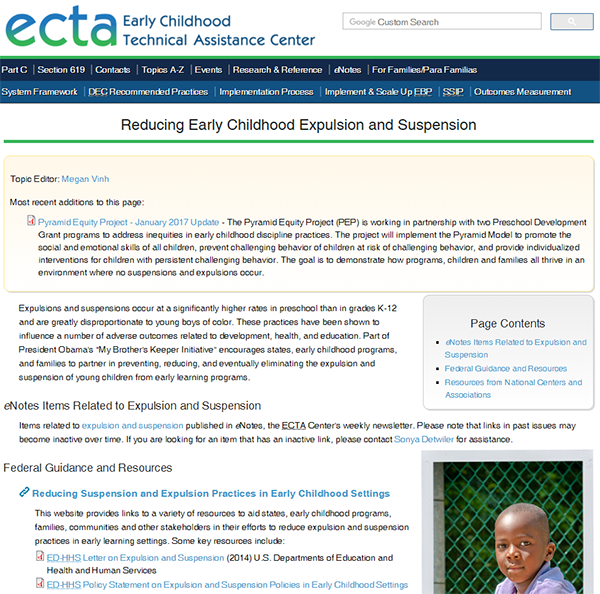Defining Suspension and Expulsion
Suspension
- In School/Program Suspension: The child is temporally removed from classroom and/or class peers. Child is sent to some other part of the school/ program (e.g., other classroom, director’s office) for part of the day or multiple days in response to problem behavior. This includes when the child is removed from the classroom to spend extended time with administrator, counselor, behavior therapist or other adult.
- Short Term Out-of-School/Program Suspension: Child is sent home for some part of the school/program day in response to problem behavior.
- Out-of-School/Program Suspension: Child is not allowed to return to school/program for one or more days in response to problem behavior.
- For children with disabilities served under IDEA (with an IEP or IFSP): Out-of school/program suspension is an instance in which a child is temporarily removed from his/her regular school/program to another setting (e.g., home, behavior center) for at least half a day in response to problem behavior. Out-of school/program suspensions include both removals in which no individualized family service plan (IFSP) or individualized education program (IEP) services are provided because the removal is 10 days or less as well as removals in which the child continues to receive services according to his/her IFSP or IEP.
Expulsion
Expulsion/Dismissal: Permanent dismissal of the child from the program in response to problem behavior. Does not include transition to another program, service or classroom (e.g., special education, transitional classroom, or therapeutic preschool program) deemed more appropriate for the child if done in collaboration with the family and the receiving classroom, program or service.
Preschool children are suspended up to three times more than students from kindergarten through 12th grades. In 2014, the United States Department of Education released the results of its 2012 Civil Rights Data Collection, which, for the first time included preschool data. The results showed that approximately 5,000 preschoolers were suspended at least once in 2012 and of those, nearly 2,500 were suspended a second time. African American children, who comprise only 18 percent of the preschool population, make up nearly half of all preschool suspensions. American Indian and Native Alaskan students represent less than 1% of the student population but up to 3% of suspensions and expulsions.
In recognition of the importance of addressing suspension and expulsion, the US Departments of Education and Health and Human Services issued a Policy Statement on Expulsion and Suspension Policies in Early Childhood Settings in 2014 that provides recommendations to States and local early childhood programs to prevent and severely limit expulsions and suspensions in early learning settings. These recommendations include the implementation of multi-tiered systems of support (i.e., Pyramid Model) and the training of staff in implementing prevention and intervention strategies and ensuring equitable practices that are free of bias and discrimination.
How to Reduce Suspensions
The Pyramid Model is an effective approach for addressing challenging behaviors that may lead to suspensions. When culturally responsive practices, which are naturally incorporated in the Pyramid Model, are highlighted during training and coaching and intentionally applied in classrooms, suspensions and racial disparities in discipline may be greatly reduced.
Culturally Responsive Practices
Effective implementation of culturally responsive practices requires a transformation in the way teachers perceive and respond to the cultural norms of children of color. Educators must have access to professional development activities that include knowledge of:
- implicit bias and its impact on decision making
- culturally responsive practices and how to implement the practices in the classroom
- the role of critical reflection in challenging assumptions, and interpreting, understanding, and reframing experiences
- strategies for preventing and addressing challenging behaviors.
Reducing Implicit Bias
In order to effectively reduce implicit bias and enhance the implementation of culturally responsive practices embedded in the Pyramid Model, teachers must engage in a journey of self-discovery that:
- makes them aware of their own biases
- capitalizes on their good intentions
- provides documentation of racial disparities
- shows how bias contributes to racial disproportionality.
Related Resources

When a child is suspended from school, it not only impacts the child, but the entire family. Parents often feel isolated and ashamed. They may also feel defeated with nowhere to turn. Many parents worry about the impact of the suspension on the child’s future, losing their job to care for the child during the suspension period, their child being targeted, and their child’s ability develop and maintain positive relationships with teachers and peers. During this webinar, parents share the impact of their child’s suspension(s) on the family.
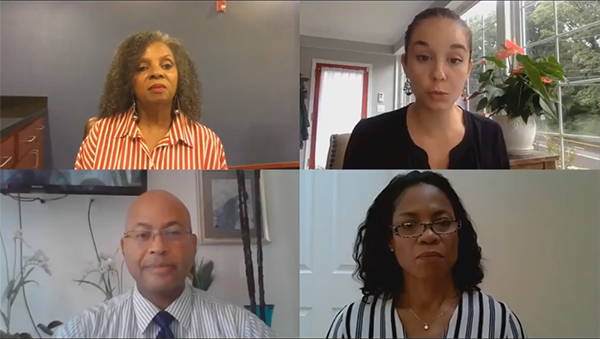
This webinar will focus on race and implicit bias in in early childhood programs. Participants will discuss the impact of racial bias on teaching, learning, perceptions of behaviors, and decision making in early childhood environments.
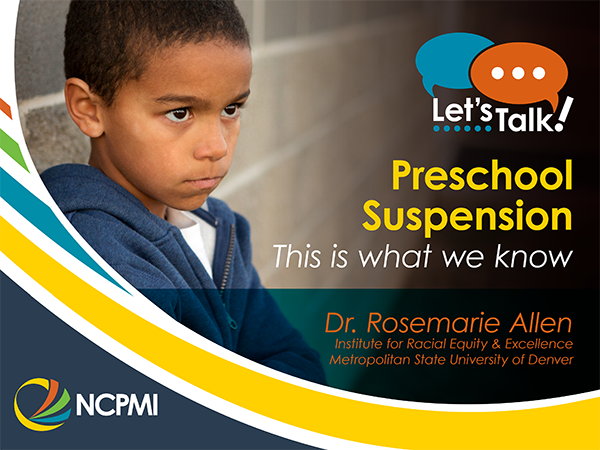
The “Let’s Talk” webinar series, hosted by Dr. Rosemarie Allen, provides panel discussions related to equity, inappropriate discipline practices, and effective strategies. This session will discuss preschool suspensions.

Panelists will share their experiences as a Pyramid Equity Program (PEP) site, discussing what worked, challenges and overall success in implementing the Pyramid Model, with a specific focus on addressing equity. They will share their experiences using equity tools such as the Behavior Incident Reporting System (BIRS) and the Pyramid Model Coaching Equity Guide.

This training provides information on the importance of culturally responsive practices in enhancing outcomes for all children, especially those from diverse backgrounds. In addition, issues concerning implicit bias are discussed. The development of this module was supported by the Pyramid Equity Project in collaboration with the University of South Florida, the University of Colorado Denver, and the PBIS Center with Preschool Development Grant national activity funding.
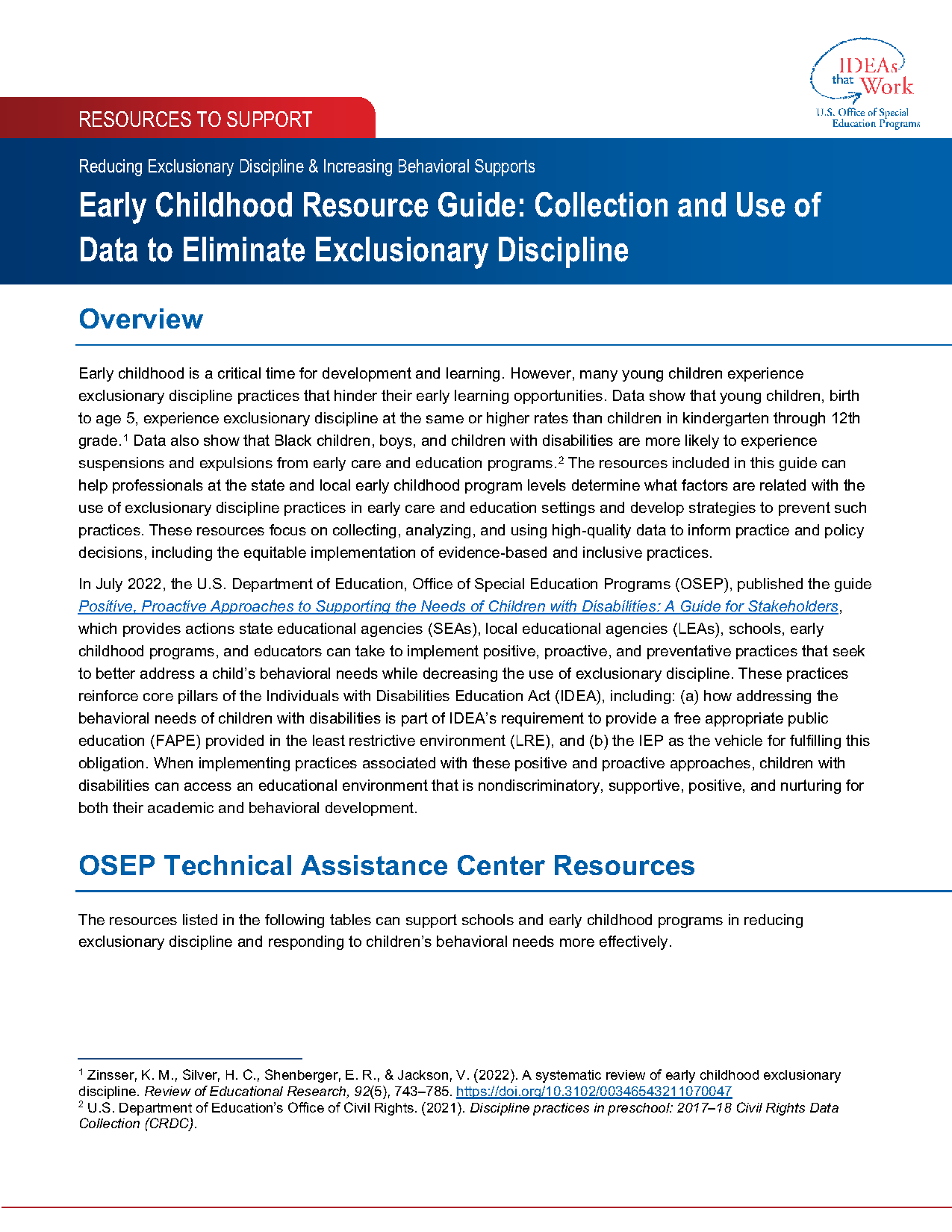
The resources included in this guide can help professionals at the state and local early childhood program levels determine what factors are related with the use of exclusionary discipline practices in early care and education settings and develop strategies to prevent such practices. These resources focus on collecting, analyzing, and using high-quality data to inform practice and policy decisions, including the equitable implementation of evidence-based and inclusive practices. This resource is part of the U.S. Department of Education Discipline/Behavior Guidance and Resources collection.

The resources included in this guide can help professionals at the State and local early childhood program levels prevent exclusionary discipline in early care and education settings and consider the impact of these practices on families. These resources focus on the equitable implementation of evidence-based and inclusive practices. This resource is part of the U.S. Department of Education Discipline/Behavior Guidance and Resources collection.

The resources included in this guide can help professionals at the State and local early childhood program levels prevent exclusionary discipline through strengthening and coordinating State and local early childhood systems; collecting, analyzing, and using high quality data to inform practice and policy decisions; and equitably implement evidence-based and inclusive practices. This resource is part of the U.S. Department of Education Discipline/Behavior Guidance and Resources collection.
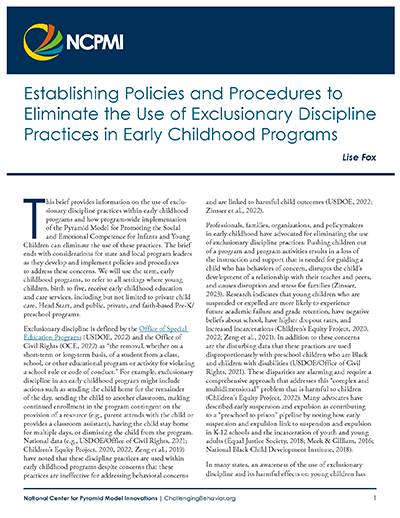
This brief provides information on the use of exclusionary discipline practices within early childhood programs and how program-wide implementation of the Pyramid Model for Promoting the Social and Emotional Competence for Infants and Young Children can eliminate the use of these practices.

This fact sheet summarizes current research findings about suspension and expulsion of children—particularly children of color—from early childhood settings. Recommendations and suggestions are offered for using the Pyramid Model to address this national problem.
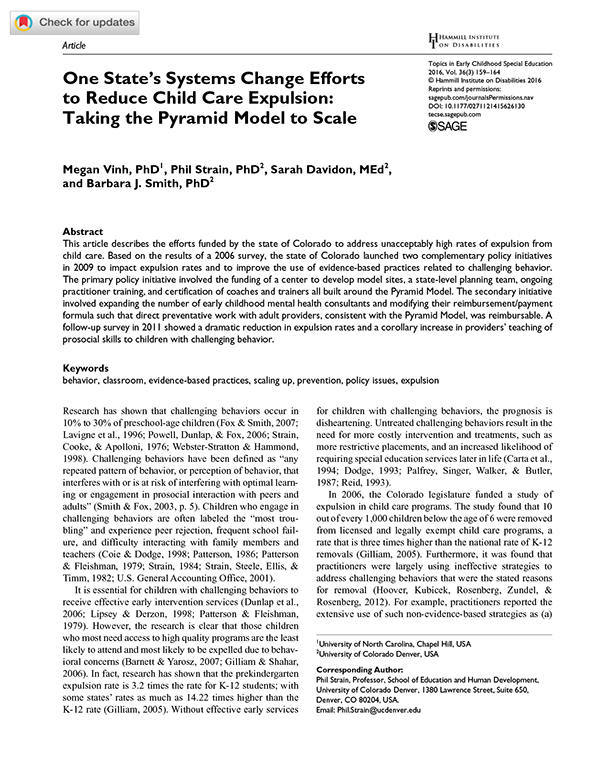
Vinh, M., Strain, P., Davidon, S., & Smith, B.J. (2016). One state’s systems change efforts to reduce child care expulsion: Taking the Pyramid Model to scale. Topics in Early Childhood Special Education, 36, 159-164.
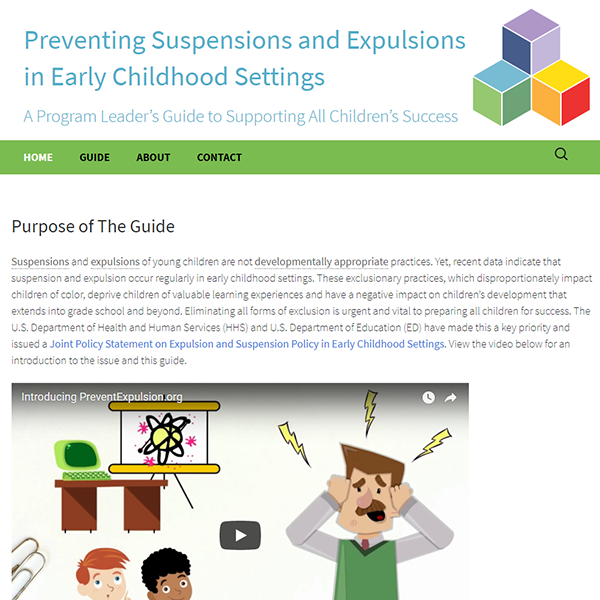
The purpose of this guide is to provide relevant, specific recommended policies and practices that are actionable and address the underlying root causes and provide effective alternatives. The recommended policies and practices are based on the most important research for eliminating suspensions and expulsions in early childhood settings and were developed with guidance from a panel of national experts.The purpose of this guide is to provide relevant, specific recommended policies and practices that are actionable and address the underlying root causes and provide effective alternatives. The recommended policies and practices are based on the most important research for eliminating suspensions and expulsions in early childhood settings and were developed with guidance from a panel of national experts. Using the interactive guide, program leaders can find resources on supporting social emotional development, reducing challenging behavior, recognizing the role of cultural differences and implicit biases, and more. The guide is intended for those most likely to make an impact and with a great need for resources: early education program leaders in center-based settings who implement policies and procedures and promote practices; however, anyone seeking to learn more about strategies for eliminating suspension and expulsion in early childhood settings can benefit from using the guide.

This document provides program leadership teams with guidance to support their efforts to eliminate suspension and expulsion and promote equitable, inclusive and culturally responsive practice in all early childhood settings including public and private schools and child care centers.
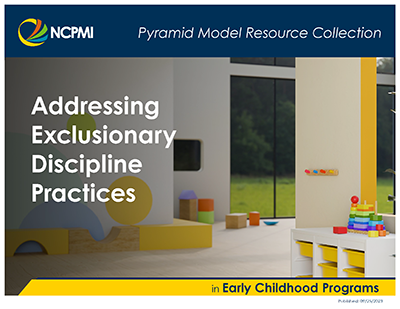
This NCPMI Resource Collection provides resources for states, communities and early childhood programs aimed to prevent the use of exclusionary practices. The resources, predominantly found on the NCPMI website, provide information about exclusionary practices related to prevention, policies, data tools, equity and impact. Formats include guides, tip sheets, fact sheets, webinars, and video.
Last Updated: 10/01/2024 ADA updates
Created: 09/25/2023

This document provides state leadership teams with guidance on how to prevent suspension and expulsion by integrating with existing efforts including Pyramid Model, Multi-Tiered System of Supports (MTSS), Quality Rating Improvement System (QRIS), inclusion and State Systemic Improvement Plan (SSIP) efforts. This resource is organized around the Guiding Principles and Recommendations from the federal Joint Policy Statement on Expulsion and Suspension Policies in Early Childhood Settings (HHS/ED, 2014).

U.S. Department of Health & Human Services, Administration for Children & Families, Early Childhood Development.
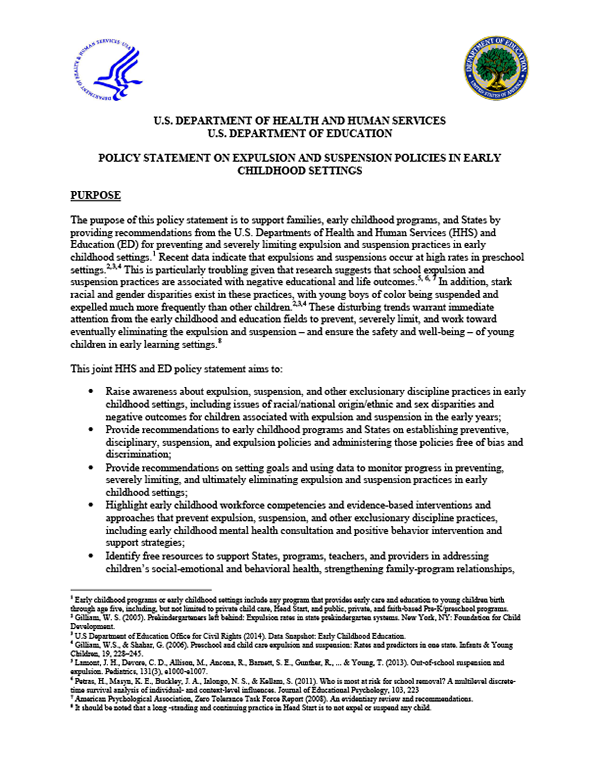
The purpose of this policy statement is to support families, early childhood programs, and States by providing recommendations from the U.S. Departments of Health and Human Services (HHS) and Education (ED) for preventing and severely limiting expulsion and suspension practices in early childhood settings.

This resource provides State Leadership Teams with guidance on the collection and analysis of behavior incident report data from programs.

